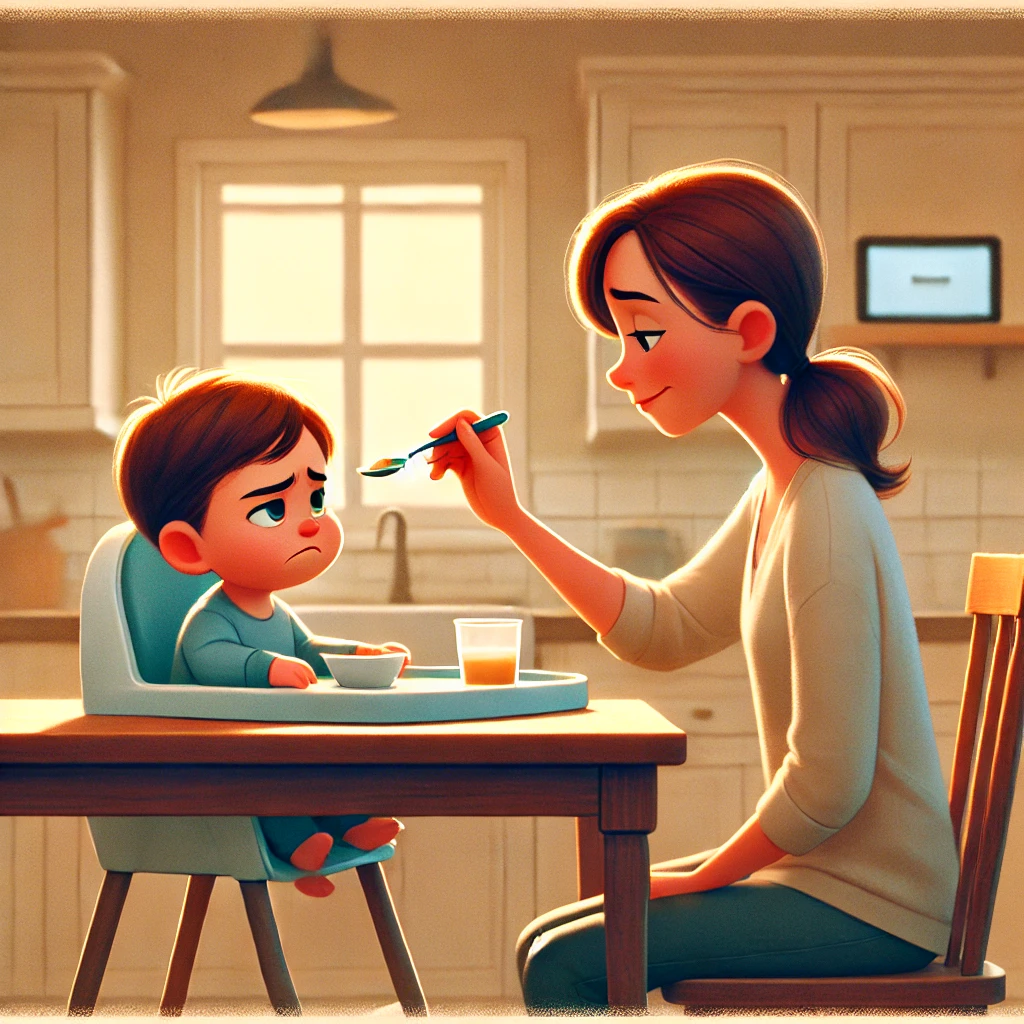
Structured Screen Transitions for Toddler Attention: Research & Expert Insights
Alternating Screen Content to Prevent “Zoning Out” and Attention Fatigue
*A young child sits transfixed in front of a bright television screen in a dark room, illustrating the so-called “zombie effect” where kids appear zoned out while watching TV[sparkandstitchinstitute.com] .
Parents often notice that toddlers can become glassy-eyed “TV zombies” when watching stimulating videos for too long[sparkandstitchinstitute.com] . Developmental research suggests this zoning out happens because fast-paced, high-stimulation screen content overwhelms young children’s attention. Psychologist Angeline Lillard’s famous study found that just 9 minutes of a fast-paced cartoon (SpongeBob SquarePants) impaired 4-year-olds’ executive function (self-control and working memory) compared to a slower-paced educational cartoon[npr.org] [npr.org] . Scenes in the fast cartoon changed every 11 seconds, which overstimulated the children’s brains, while the slower show (scene changes ~34 seconds) did not cause these problems[npr.org] . “It’s overstimulation that causes the problem,” explains pediatrician Dimitri Christakis – the rapid barrage of novel sights and sounds can make it harder for a developing brain to focus on sustained tasks later on[npr.org] . Other experts agree that too much fast-switching, high-intensity media can wear out kids’ attention. Psychologist Craig Anderson notes that when young kids watch a lot of rapid-fire shows that jump quickly from scene to scene, **“they may later have trouble when they need to focus in the classroom.”**[webmd.com] This suggests their attention system gets fatigued or conditioned to constant changes.
Varying the type and pace of screen content can help avoid this trance-like fatigue. Research indicates children actually pay better attention to content that engages them meaningfully, rather than just flashy visuals. For example, toddlers will lose interest in disjointed, nonsensical videos, but stay cognitively engaged with a storyline they can follow[sparkandstitchinstitute.com] . Alternating between an exciting, high-stimulation clip and a calmer, more educational segment provides a sort of “reset.” The shifts in pace prevent prolonged hypnotic viewing, requiring the child to reorient their attention and process a different type of stimulus. Over time, this can break the habit of tuning out. Pediatric specialists note that content quality matters as much as quantity – “an hour or two of SpongeBob is way worse than two hours of Caillou,” Christakis says[npr.org] . By mixing “Caillou-like” moments (slower, educational content) into screen time, parents can reduce the risk of attention burnout that comes from nonstop fast entertainment. In short, intentional alternation of high vs. low stimulation content keeps a toddler’s brain from going on autopilot, thereby helping them stay engaged without getting overloaded.
Transitional Tools as a Bridge to Screen-Free Routines
Going from constant screen reliance to zero screen time overnight can be jarring for a toddler (and practically difficult for parents). Experts recommend using gradual, structured changes – essentially bridges – to gently reduce dependence on screens. In practice, this means introducing “partial” screen experiences or controlled routines that ease the child toward living without that digital crutch. Here are a few research-backed transitional strategies:
- Swap Video for Audio (Partial Screen): One clever tip from an early childhood teacher is to play children’s podcasts or audio stories on the TV instead of videos when a break is needed
[mother.ly] > . The screen might be on, but only sound (e.g. a PBS Kids story podcast) comes out, often paired with a calm activity like coloring. This gives the child entertainment and a familiar device without the intense visual stimulation, helping them “reset” out of screen zombie mode
[mother.ly] > . It’s essentially a stepping stone: the toddler still hears a fun story from the tablet/TV (so the transition isn’t too abrupt), but they aren’t glued to moving cartoons.
- Use Apps/Timers to Structure Viewing: Rather than free-for-all screen use, parents can impose a predictable structure that limits duration and switches context. Pediatricians advise making screen limits “a regular part of use” – for example, always ending a video after one short episode – so that toddlers come to expect the stop and don’t fight it
[webmd.com] > . Technology can help: “Use programs and apps that you can set to turn off... after a given amount of time,” one expert suggests
[webmd.com] > . Tools like this (for instance, an app that auto-switches or stops videos at preset intervals) enforce breaks consistently, saving parents from constant bargaining. This structured approach aligns with the idea behind SwitchTube’s timed switches – it leverages technology to impose intervals and prevent endless viewing.
- Gradually Replace Mealtime Screens: Many families struggle with toddlers demanding screens at the dinner table. Research on reducing preschoolers’ screen time found that a highly effective strategy was implementing firm “screens-off during meals” rules combined with alternate activities
[canopy.us] >
[canopy.us] > . In other words, start with small screen-free rituals (like no tablet at breakfast a few days a week, perhaps engaging the child with feeding themselves or talking about the food instead). Scheduling specific screen-free times (bedtime, car rides under 15 minutes, etc.) creates a routine where the child learns to manage without digital entertainment at those moments
[canopy.us] > . Over time these screen-free pockets can be expanded. The key is consistency: the child can anticipate that, say, “at meals we do other things,” making it a normal habit rather than a sudden deprivation.
Why are these gradual strategies important? Neuroscience offers a big clue. When a child has been deeply engrossed in a screen and we suddenly shut it off, their brain undergoes a swift drop in dopamine, the pleasure chemical[parent.com] . One parenting expert explains that a toddler’s brain during screen-time is “awash” in dopamine and “to turn the off switch... feels like a shock of physical pain” to them[parent.com] . No wonder they scream and meltdown! Transitional tools help avoid that harsh crash by slowly dialing down engagement instead of cutting it off. Think of it as landing the plane smoothly versus a free-fall drop. By using intermediate steps like partial screens or structured breaks, we teach toddlers to handle a bit of boredom or calm in doses, building their tolerance for longer screen-free periods. Over weeks and months, these gentle reductions retrain the child’s ability to cope without constant digital stimulation – paving the way for a truly screen-free mealtime or routine in the future.

Expert Insights on Managing Attention, Overstimulation, and Content Quality (Ages 1–4)
Child development experts – pediatricians, psychologists, and researchers – are largely in agreement about moderating both how much and how young children use screens. Here are some key expert guidelines relevant to toddlers’ attention and sensory needs:
- Limit Total Screen Time and Choose Quality Content: The American Academy of Pediatrics recommends no screens at all for infants under 18 months, and only “high-quality” programming (like educational shows or video-chat with family) for toddlers ages 2–5, capped around 1 hour per day
[latimes.com] > . Crucially, they advise avoiding fast-paced apps or shows and violent content for young kids
[latimes.com] > . This is because rapid, flashy media can over-stimulate toddlers (as we saw with SpongeBob’s effects). Instead, experts suggest choosing slower-paced, educational videos (think Sesame Street or Bluey) and co-viewing with your child when possible
[latimes.com] > . By watching together, parents can help toddlers make sense of what they see and keep them from just tuning out passively.
- Don’t Rely on Screens to Calm or Babysit: Pediatric specialists warn against using screen media as an automatic soothing tool for tantrums, boredom or meals
[latimes.com] > . Handing a tablet to stop a fuss may save sanity in the moment, but it robs the child of learning to self-regulate and can lead to more meltdowns when the screen is unavailable. The AAP specifically says **“Don’t use screens to calm a fussy child.”**
[latimes.com] > Toddlers need practice with other coping methods (like a caregiver’s comfort, or expressing feelings). Psychologist Michael Rich (known as “the Mediatrician”) points out that much of what happens on a screen is “impoverished stimulation” for a toddler’s developing brain compared to real-life interaction
[hms.harvard.edu] > . For healthy development, little ones require a **“diverse menu of online and OFFline experiences, including the chance to let their minds wander.”**
[hms.harvard.edu] > In fact, “boredom is the space in which creativity and imagination happen,” Rich notes
[hms.harvard.edu] > . This underscores that constant screen engagement can crowd out critical time for pretend play, hands-on exploration, and daydreaming – all of which build attention span and resilience.
- Watch for Signs of Overstimulation or Sensory Overload: Research is increasingly showing that excessive screen exposure in infancy and toddlerhood can alter how young children process sensory information. A 2024 study in JAMA Pediatrics linked higher screen use before age 2 to more frequent “atypical sensory behaviors” by 33 months old
[drexel.edu] >
[drexel.edu] > . Toddlers with lots of screen time were more likely to be disengaged or “low registration” (slow to respond to their name), or on the flip side to constantly seek intense stimulation and have trouble with loud sounds/bright lights
[drexel.edu] > . In essence, heavy screen users might either tune out the world or become extra-sensitive and overwhelmed by it. Pediatricians explain that young kids are hardwired to pay attention to novel sounds and colorful motion (hence the screen’s magnetic “zombie” pull)
[sparkandstitchinstitute.com] > . But if they’re bombarded with digital stimuli, they may become numb to moderate stimuli and only perk up for extreme input – or their system swings the other way and can’t cope with any stimulation (like a loud noise triggers tears). To avoid this, experts recommend moderation and balance: for example, if your 2-year-old watches a lively cartoon in the morning, opt for a calm, hands-on activity next so their sensory system recalibrates. Pay attention to your child’s behavior during and after screen use – if they seem zoned out, irritable, or overstimulated, it’s a sign to dial back the intensity. As one summary of pediatric advice put it, *“What is this screen time displacing?"*
[webmd.com] > – make sure it’s not replacing naps, outdoor play, conversation or other vital experiences.
- Content and Context Over Quantity Alone: Experts stress that how a young child uses screens matters more than an absolute minute count
[hms.harvard.edu] > . Dr. Rich notes, *“It’s not how long we’re using screens... it’s how we’re using them and what’s happening in our brains in response."*
[hms.harvard.edu] > Are they passively consuming flashy cartoons, or engaging in a slow-paced interactive story with a parent? Two toddlers could have the same 30-minute screen time, but one might be hyper and cranky afterward while the other is calm and chirping about the alphabet song they just learned. The difference is the content and the child’s engagement. Whenever possible, choose media that invites participation (sing-alongs, simple narratives, age-appropriate lessons) and watch together to guide understanding
[latimes.com] > . By moderating the sensory input and making screen time more interactive, you help protect your toddler’s attention span and mental state. And always offset screen time with rich off-screen activities – building blocks, chasing bubbles, reading board books – so their brains get the full range of stimulation they need.

“Smart Switching” Strategies and Gradual Sensory Downshifting in Practice
Parents and experts have developed some savvy tactics to manage screen transitions and gradually downshift toddlers’ sensory input, rather than stopping on a dime (which we know can trigger tantrums). Implementing these “smart switching” strategies can make it easier to end screen sessions and guide little ones toward calmer, screen-free activities:
- Build a Gentle Bridge Out of Screen Time: Clinical psychologist Isabelle Filliozat advises parents to join the child’s world for a minute before turning off the screen
[parent.com] >
[parent.com] > . Instead of abruptly saying “time’s up” (which feels like a rug pull to a toddler’s brain), sit with them and talk about what they’re watching: e.g. “Who is that character? What are they doing?” This brief engagement helps pull the child’s attention outward. When they start responding or pointing, they’re already coming out of the trance and back to reality slowly, so the dopamine drop isn’t so sudden
[parent.com] > . “The dopamine doesn’t drop abruptly, because you’ve built a bridge,” Filliozat explains – the child crosses from the screen world to the real world with your help
[parent.com] > . After that, you can gently announce it’s time to turn it off, and they’re in a headspace to handle it. Many parents find this prevents the usual screaming, and some toddlers even happily turn off the TV themselves after this warm reconnect
[parent.com] > .
- Use a “Cool-Down” Video or Activity: Another smart-switch approach is to end with calmer content as a transition. For instance, if your child just watched an exciting cartoon, you might follow up with a short, quiet educational clip or a soothing song video before powering down. The idea is to gradually lower the sensory intensity so it’s not an abrupt plunge from 100 to 0. One parent strategy along these lines is using an audio story at the end of screen time (as mentioned earlier with podcasts on TV) – the child is still engaged by a narrative, but without the bright moving images, their arousal level comes down
[mother.ly] > . Even dimming the screen or lowering volume towards the end of a session can signal that fun time is winding down. Think of it like a bedtime routine: you wouldn’t go from riling a toddler up straight to lights-out; you do bath, then books, then lullaby. Similarly, smart switching tapers down stimulation in steps.
- Plan Breaks and Warnings: Experts also suggest structuring mini-breaks during screen time to avoid complete immersion. Pediatric therapists at Beacon Services recommend taking a brief break midway through a screen session and giving 10-minute and 5-minute warnings before it ends
[beaconservices.org.uk] > . For example, if a toddler is watching a 20-minute video, pause at the 10-minute mark to ask a quick question or have them sip water – this momentary interruption keeps them from getting too glued and reminds them the activity is finite
[beaconservices.org.uk] > . Then, a friendly “five more minutes, then we’re all done” alert gives them a chance to emotionally prepare. These techniques help “stay connected to time” for kids who easily lose themselves in an immersive app or show
[beaconservices.org.uk] > . Incorporating SwitchTube’s alternating intervals can naturally create such breaks – the switch to an educational video is a cue that time is passing and change is coming, mitigating shock when the fun video doesn’t just run indefinitely.
- Introduce Gradual Sensory Changes: A creative downshifting idea is to change the sensory input one element at a time. For instance, let’s say your child is watching a very stimulating dance video on full tablet screen with sound. You might first reduce the visual intensity – e.g., shrink the window or move farther from the screen – and let them just listen to the song for a bit (so now it’s more like listening to music). Then you pause it entirely and perhaps replace it with a real-world activity that still ties in, like singing the song together or dancing without the screen. This stepwise reduction (full audiovisual -> audio-only -> off) helps the child adapt at each step instead of going cold turkey. It’s essentially what SwitchTube facilitates by switching from an entertaining video to an educational one (typically these have gentler visuals or more learning-focused content) at set intervals. The educational segments act as a “sensory downshift” – they tend to be calmer or slower, easing the child’s level of stimulation down from the peak, so that when screen time does end, the child isn’t at a hyper-aroused peak.
In summary, research and expert guidance support the idea that intentional switching of content and structured screen routines can retrain toddlers’ attention and reduce overreliance on screens. By alternating high-stimulation entertainment with slower, educational media, parents can prevent the prolonged trance and overload that pure entertainment might cause. And by using transitional tactics – whether a smart app like SwitchTube that auto-switches content, or simple parenting tricks like podcasts and play breaks – families can gradually wean toddlers off passive screen dependence. Over time, these gentle adjustments help toddlers learn to handle calmer activities and eventually enjoy meals or playtime without any screen at all. The goal is a healthier relationship with media: one where the child stays engaged and learning during limited screen time, but can also turn it off without a battle, their attention intact and ready for the next adventure.[npr.org] [latimes.com]


